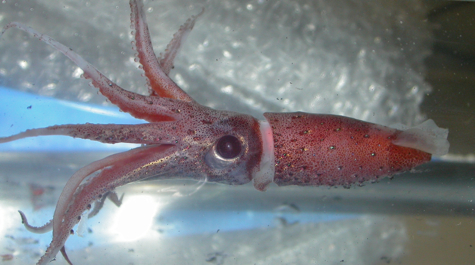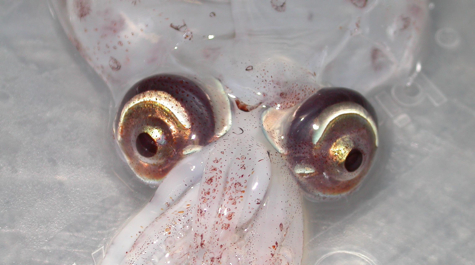Researchers explore mysteries of the deep
VIMS researchers have departed for a 6-week expedition to the deep waters of the North Atlantic as part of the Census of Marine Life, a global, 10-year study of the diversity, distribution, and abundance of life in the oceans.
Aboard the 208-foot NOAA Fisheries vessel Henry B. Bigelow are professors Mike Vecchione and Tracey Sutton, along with graduate student C.J. Sweetman. They join a team of scientists from around the nation and world.
The overall goal of the expedition is to further explore the deep-water ecosystems of the northern mid-Atlantic Ridge, an area last visited by Vecchione and Sutton in 2004 as part of the Mid-Atlantic Ridge Ecosystem Project (MAR-ECO). Like other parts of the deep ocean, the waters above the mid-Atlantic ridge are poorly known. “The realm below 3,000 feet makes up more than 90% of the biosphere, but it’s the part of the Earth that we know the least about,” says Vecchione.
MAR-ECO, coordinated by the Institute of Marine Research at the University of Bergen in Norway, is a 16-nation effort to survey the waters around the mid-Atlantic Ridge from Iceland to the Azores. It is one of 14 Census of Marine Life field projects. The U.S. component of MAR-ECO is funded by the the National Marine Fisheries Service and NOAA’s Ocean Exploration Program.
Marine biologists are interested in mid-ocean ridges, underwater mountain chains that encircle the Earth like seams on a baseball, because they may affect the distribution of marine life by influencing ocean circulation patterns. Researchers would particularly like to know if ridge waters have their own characteristic animal communities.
Vecchione, a NOAA Fisheries researcher and adjunct faculty at VIMS, will serve as the expedition’s Chief Scientist. A world-expert on deep-sea squid, he will be on the lookout for new and unusual squid species to compare to those collected during earlier MAR-ECO cruises. In addition to participating in the 2004 expedition, Vecchione led a 2003 expedition to the area using the Russian Mir submersibles to dive as deep as 15,000 feet.
Sutton, an assistant professor at VIMS, is aboard the Bigelow as the lead investigator on a project funded by the National Science Foundation. The focus of his study is to better understand deep-sea food webs.
“The deep sea was once considered pristine and undisturbed,” says Sutton, “but it’s now starting to be impacted by human activities.” Primary among these is commercial trawl fishing, which is moving into ever-deeper water.
“Understanding the dynamics of deep-sea food webs is essential for ocean management and policy,” says Sutton. “Our study will provide new information about ‘who’s eating whom’ in the deep sea, and the ecological forces that shape ocean communities.”
Vecchione adds “It makes sense to explore and study deep-water habitats before large-scale exploitation begins in the North Atlantic.”
Knowledge of deep-sea food webs will help fishery managers better assess the impact of removing top predators by deep-sea fishing. “A recent study found that the diversity of top ocean predators has declined between 10% and 50% in the past 50 years,” says Sutton. “The protection of regional "hotspots" may thus be critical in thwarting what may be an ecological disaster.”
Sutton is excited to once again team up on a MAR-ECO cruise, as previous MAR-ECO expeditions have generated one of the largest collections of deep-sea creatures ever assembled.
“The current expedition will build on this collection to gain an unprecedented understanding of deep-sea food webs,” says Sutton. “Access to MAR-ECO’s comprehensive dataset, and the opportunity to work on the Bigelow with some of the world's foremost experts on deep-sea taxonomy and ecology, represent a huge added value and cost savings.”
Sutton, himself an expert in the ecology and identification of deep-sea fishes, will collaborate with his graduate students to determine the diet of these fishes by examining gut contents, measuring stable-isotope ratios of predator tissues, and recording the DNA “fingerprints” of prey. In addition to shipboard help from Sweetman, Sutton will also receive assistance back at VIMS from graduate students Kristene Parsons and Gina Kidwell.
Sutton is particularly interested in further exploring a surprising discovery from earlier MAR-ECO cruises—the fact that some deep-sea fishes apparently rely in large part on jellyfish and other gelatinous animals for food. These fishes include bristlemouths, deep-sea smelts, and bigscale fishes.
Expedition scientists will use a variety of tools to explore the deep ocean, including trawls and sonar. The Bigelow is capable of trawling in waters as deep as 6,000 feet, and features a “quiet” hull that minimizes sound made by the ship underwater. Quiet-hull technology allows scientists to use hydroacoustic methods to survey marine life, and significantly reduces changes in animal behavior due to ship noise.
The expedition will be divided into two parts. A preliminary leg took place from June 8-10 in the waters off New England. This “shake-down” cruise was designed to test deployment of deep-water gear from the Bigelow. After returning to port at the Newport Naval Station in Newport, Rhode Island, the Bigelow will steam to the mid-Atlantic Ridge, where onboard scientists will conduct research from June 12th to July 17th. This portion of the cruise will target a section of the mid-Atlantic Ridge known as the Charlie Gibbs Fracture Zone (centered on 53° N; 035° W). Water depths in this area range from 3,000 to almost 15,000 feet.
During both legs of the expedition, researchers will save their bottom trawls for last, to minimize the chance that a “hung” net might jeopardize subsequent research. That’s a lesson learned from an earlier research cruise on which a bottom trawl snagged the seafloor a mile down. The rugged topography of the mid-Atlantic Ridge is one reason that its deep-water organisms remain so poorly known.
In addition to the researchers from VIMS, the current expedition includes researchers from the American Museum of Natural History, Harbor Branch Oceanographic Institution, the Los Angeles County Museum, the National Marine Fisheries Service's Woods Hole Laboratory, the Smithsonian Institution, the University of the Azores, the University of Georgia, the University of St. Andrews in Scotland, and Woods Hole Oceanographic Institution. Also onboard is a NOAA "Teacher at Sea" from Opelika Middle School in Alabama.


